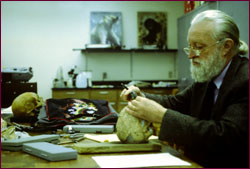 |

|
An antagonist's perspective by C. Loring Brace I am going to start this essay with what may seem to many as an outrageous assertion: There is no such thing as a biological entity that warrants the term "race." The immediate reaction of most literate people is that this is obviously nonsense. The physician will retort, "What do you mean 'there is no such thing as race'? I see it in my practice everyday!" Jane Doe and John Roe will be equally incredulous. Note carefully, however, that my opening declaration did not claim that "there is no such thing as race." What I said is that there is no "biological entity that warrants the term 'race'." "You're splitting hairs," the reader may retort. "Stop playing verbal games and tell us what you really mean!" And so I shall, but there is another charge that has been thrown my way, which I need to dispel before explaining the basis for my statement. Given the tenor of our times at the dawn of the new millennium, some have suggested that my position is based mainly on the perception of the social inequities that have accompanied the classification of people into "races." My stance, then, has been interpreted as a manifestation of what is being called "political correctness." My answer is that it is really the defenders of the concept of "race" who are unwittingly shaped by the political reality of American history. [Read a proponent's perspective, that of anthropologist George Gill.]
The nature of human variation I would suggest that there are very few who, of their own experience, have actually perceived at first hand the nature of human variation. What we know of the characteristics of the various regions of the world we have largely gained vicariously and in misleadingly spotty fashion. Pictures and the television camera tell us that the people of Oslo in Norway, Cairo in Egypt, and Nairobi in Kenya look very different. And when we actually meet natives of those separate places, which can indeed happen, we can see representations of those differences at first hand. But if one were to walk up beside the Nile from Cairo, across the Tropic of Cancer to Khartoum in the Sudan and on to Nairobi, there would be no visible boundary between one people and another. The same thing would be true if one were to walk north from Cairo, through the Caucasus, and on up into Russia, eventually swinging west across the northern end of the Baltic Sea to Scandinavia. The people at any adjacent stops along the way look like one another more than they look like anyone else since, after all, they are related to one another. As a rule, the boy marries the girl next door throughout the whole world, but next door goes on without stop from one region to another.
Then if we take that scourge sickle-cell anemia, so often thought of as an African disease, we discover that, while it does reach high frequencies in some parts of sub-Saharan Africa, it did not originate there. Its distribution includes southern Italy, the eastern Mediterranean, parts of the Middle East, and over into India. In fact, it represents a kind of adaptation that aids survival in the face of a particular kind of malaria, and wherever that malaria is a prominent threat, sickle-cell anemia tends to occur in higher frequencies. It would appear that the gene that controls that trait was introduced to sub-Saharan Africa by traders from those parts of the Middle East where it had arisen in conjunction with the conditions created by the early development of agriculture. Every time we plot the distribution of a trait possessing a survival value that is greater under some circumstances than under others, it will have a different pattern of geographical variation, and no two such patterns will coincide. Nose form, tooth size, relative arm and leg length, and a whole series of other traits are distributed each in accordance with its particular controlling selective force. The gradient of the distribution of each is called a "cline" and those clines are completely independent of one another. This is what lies behind the aphorism, "There are no races, there are only clines." Yes, we can recognize people from a given area. What we are seeing, however, is a pattern of features derived from common ancestry in the area in question, and these are largely without different survival value. To the extent that the people in a given region look more like one another than they look like people from other regions, this can be regarded as "family resemblance writ large." And as we have seen, each region grades without break into the one next door.
America and the race concept The role played by America is particularly important in generating and perpetuating the concept of "race." The human inhabitants of the Western Hemisphere largely derive from three very separate regions of the world—Northeast Asia, Northwest Europe, and Western Africa—and none of them has been in the New World long enough to have been shaped by their experiences in the manner of those long-term residents in the various separate regions of the Old World. It was the American experience of those three separate population components facing one another on a daily basis under conditions of manifest and enforced inequality that created the concept in the first place and endowed it with the assumption that those perceived "races" had very different sets of capabilities. Those thoughts are very influential and have become enshrined in laws and regulations. This is why I can conclude that, while the word "race" has no coherent biological meaning, its continued grip on the public mind is in fact a manifestation of the power of the historical continuity of the American social structure, which is assumed by all to be essentially "correct." Finally, because of America's enormous influence on the international scene, ideas generated by the idiosyncrasies of American history have gained currency in ways that transcend American intent or control. One of those ideas is the concept of "race," which we have exported to the rest of the world without any realization that this is what we were doing. The adoption of the biologically indefensible American concept of "race" by an admiring world has to be the ultimate manifestation of political correctness. Dr. C. Loring Brace is professor anthropology and curator of biological anthropology at the Museum of Anthropology, University of Michigan, Ann Arbor. Does Race Exist? | Meet Kennewick Man Claims for the Remains | The Dating Game | Resources Transcript | Site Map | Mystery of the First Americans Home Editor's Picks | Previous Sites | Join Us/E-mail | TV/Web Schedule About NOVA | Teachers | Site Map | Shop | Jobs | Search | To print PBS Online | NOVA Online | WGBH © | Updated November 2000 |
 Dr. C. Loring Brace
Dr. C. Loring Brace
 Brace challenges the notion that his position
on race is a manifestation of "political correctness."
Brace challenges the notion that his position
on race is a manifestation of "political correctness."
 Until Copernicus challenged the notion, common sense said
the sun revolved around the Earth. Should we be challenging our common-sense
notion of "race"?
Until Copernicus challenged the notion, common sense said
the sun revolved around the Earth. Should we be challenging our common-sense
notion of "race"?
 While in skin color
Europeans and Chinese are closer to each other than either is to Africans, the
distribution of blood groups indicates that Europeans and Africans are closer
to each other than either is to Chinese.
While in skin color
Europeans and Chinese are closer to each other than either is to Africans, the
distribution of blood groups indicates that Europeans and Africans are closer
to each other than either is to Chinese.
 America has a leading role in generating and perpetuating
the concept of "race," Brace says.
America has a leading role in generating and perpetuating
the concept of "race," Brace says.